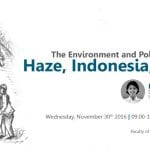Drawing ASEAN Limits and Strengths in Tackling Terrorism: Study Case of Abu Sayyaf Group
Novita Putri Rudiany-Kholifatus Saadah
1st Winner of Call for Essay: “ASEAN Community post 2015”
ASEAN actually had discussed terrorism issue before 9/11 happened, since the summit in 1997 and continued until the signing of the ASEAN Convention on Counter Terrorism in Cebu Philippines on January 13, 2007 (Soesilowati 2011). On average in Southeast Asia, the terrorism issues come from the separatist movement or motion-based Islam. One of the terrorist movement, is the Abu Sayyaf Group (ASG) which based in the Philippines. They have the principle for attacking other religious groups and believe that violence is the only way in the fight against others (Tan 2001). ASG has close connection with the world terrorist groups, and particularly Janjalani is well-known as Afghanistan war veterans. Recently, the ASG captivity was proven to hijacking action to the vessels crew from Indonesia and Malaysia. As quoted by the BBC (2016) ASG will not release the hostages if no ransom crate desired. Indonesia’s Chief Security Minister, Luhut Pandjaitan, said conditions were carried out by ASG is an act of “New Somalia”. They also proved involved in the number of bombings, kidnappings, assassinations, and extortion activities alleged to them either by the Government of the Philippines, ASEAN and the international community (Banlaoi 2006). This is a challenge for ASEAN, especially what had been done by the ASG is no longer bound by the state but transnational crime.
Regional Security Complex Theory: How ASEAN See the Terrorism as Threat
Regional Security Complex is describing how a regional look at the concept of security in the region, that revealed the concept of security will be shaped by the dynamics which occurred in a certain region. There are at least two main concepts that establish Regional Security Theory Complex (RSCT), first is power relations and second is pattern of amity and enmity. Power relations are concepts that are formed when the dynamics of a particular area then influenced by forces that are owned by its members (Buzan & Waever 2003). This conception will show how a country responds to the actions of other countries in their region, which is based on the relationship of forces between them. In the case of terrorism, as the Philippines could no longer tackle the actions of ASG, this country emphasized terrorism issue as emergency condition that should be responded immidiately. Therefore, there was effort from other ASEAN member countries to establish a framework in order to provision the common understanding in combating terrorism. Moreover, ASG was not only about terrorism but also connected with the human rights violence transnationally.
The second concept is the pattern of amity and enmity. This concept illustrates the pattern of relations between countries will establish, by construction, the dynamics in the region. ASEAN countries began to see the terrorist as a common threat, visible from ACCT formation in 2007. The dynamics that occur in ASEAN has been encouraging members to no longer see that terrorism is a threat to the security of single country, but the Southeast Asia region as a whole. In addition, the constellation internationally outside the Southeast Asian region also formed the view that the ASG is a threat to both members of ASEAN and the international community because the target they were after not only the local population but also involve foreign residents, especially the American (Sailing Totem 2014).
ASEAN Limits in Combating Terrorism
We argue that the limitations lie both in the elite side and the civil society side. First, ASEAN is good in creating framework, but weak in implementing it. Regarding the issue of terrorism, ASEAN works not only among its member states, but also with dialogue partners. Starting from 2001, member countries stipulated “ASEAN Declaration on Joint Action to Counter Terrorism” (asean.org 2016). Five years later, ASEAN Convention on Counter Terrorism established. Then in 2015, there was special ministerial meeting to respond the rise of radicalization and violent extremism. Recently in 2016, ASEAN Foreign Ministers’ announced the statement regarding terrorist attack in Jakarta (asean.org 2016). From this timeline, ASEAN is still having problem in conducting common policy. They took long time to ratification the convention and apply the real action, while the terrorist could have planned the following insurgences.
From the civil society side, first is the Islam majority, but they feel like minority. Radical to extremist Islamic militant spread the issue that the need to uphold the Islamic norms to fight the injustice treatments by the state government. Paying attention to the case of ASG, it is obvious that they demands of the recognition of their existence and aims to build a distant caliphate as it pledged allegiance to the ISIS (Almuttaqi 2016). Second, they usually recruit people from the low economic and education level and organize the training inside the unreachable zone near the states border which is out of government control. These target citizens has no enough information about the propaganda of terrorist. Therefore, they are easily provoked to the promises of the radical and extremist Islamic groups.
Strengthening ASEAN Power to Fight Terrorism
Addressing those two backgrounds of limitations, there are two approaches to strengthen the ASEAN power. On one side is, what the elite should do in creating applicable strategies regionally. On the other side is, how to empower the society and raise the awareness to the terrorist propaganda. At the government level, ASEAN framework in combating terrorism is an enough base to set up real actions. Moreover, the cooperation among some countries has been establish such as sharing intelligence from Malaysia, Indonesia and Singapore in 2002 (David 2002). The following should be commitment to push the law enforcement to avoid the reluctant behavior of member countries, and establishing concrete instruments as well. The urgency of reinterpreting ASEAN common understanding does matter. Thus, ASEAN could conduct specific tactics to fight terrorism. Also, transparency in judicial process should be underpin so that anti-terror laws are not used for political purposes but specifically as security tools.
Later, as radical to extremist Islamic militants are targeting the mind of the people, therefore civil society should also play active role to educate each other. Southeast Asia consist of heterogenic ethnics and cultures, thus it is important to put force in respecting human beings. Besides, ASEAN needs to develop local, data-driven restorative approaches to prevent and rehabilitate radicalization (Greer and Watson 2016). In short, ASEAN needs militarily force also increase economic development, social stability, and political participation also need to work for more structural change (Swanstrom dan Bjornehed 2004).





